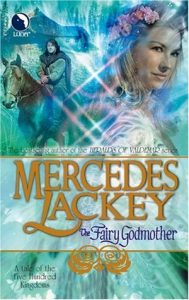
I’ve mentioned before that I’m a sucker for fairy tales. It shouldn’t be surprising then that Mercedes Lackey’s Five Hundred Kingdoms series appeals to me. In this fantasy world, the magic system is The Tradition: a mindless force that tries to push people’s lives down familiar pathways: Sleeping Beauty, the Crystal Mountain, etc.
Unfortunately, The Tradition doesn’t care if the story has a happy ending or a tragic one, and sometimes the pressure pushing someone in one direction builds to the breaking point when the story doesn’t quite fit. Like Elena in The Fairy Godmother who should have been Cinderella, if her prince hadn’t been eleven years old.
This is where the godmothers and other intermediaries between the humans and the fae come in, to steer stories towards happy ending by manipulating or diverting The Tradition, or even occasionally breaking the old patterns and creating new ones.
The Tradition is a clever idea, and the world of the Five Hundred Kingdoms gives Lackey free rein to have fun exploring and combining a wide assortment of fairy tales. Beauty and the Werewolf, for example, is a mashup of werewolf stories, Little Red Riding Hood, and Beauty and the Beast. The sources are mostly northern European, but she also draws from Greek and Japanese traditions, and possibly others that I didn’t notice.
There are a half-dozen books in this series, starting with The Fairy Godmother, and they are all light, fluffy fun with happy endings. Or maybe not so light—The Fairy Godmother is nearly 500 pages—but they are easy reads, and after blogging about the Children of the Black Sun in the last post, I needed that.
They do, however, have a few problems:
- They remind me of this quote: if I had more time, I would have written a shorter letter. Lackey is a very prolific author, publishing at the rate of five or six books a year, and it shows. They could all have used another editing pass, trimming out redundancies and tightening the story by fifty to a hundred pages. Catching some of the internal consistency errors, sloppy writing, and typos would have been nice, too.
- Beauty and the Werewolf is really annoying, mainly because it rather misses the point of both the werewolf and Beauty and the Beast stories. The beast should be a riveting and, at least initially, morally ambiguous character; this one is dull, and upstaged by his half-brother.
- And finally, there are sex scenes in at least two: The Fairy Godmother and Fortune’s Fool. (There may be others. I don’t remember; it’s been a while since I’ve read the whole series.) The scenes are short and easily skipped, but seemed jarringly out of step with the tone of the rest of the material, which would otherwise have been suitable for even pre-teens. Moreover—and more unforgivably—the romance in The Fairy Godmother equates lust with love and glosses over sexual assault. (So does Beauty and the Werewolf.) I realise this is not uncommon in the romance genre, and this series is published by Luna Books, an imprint of Harlequin, but this may be part of why I don’t read much in that genre, despite loving a good romance.
Audience: Varies. Minimal violence, but a few sex scenes.
